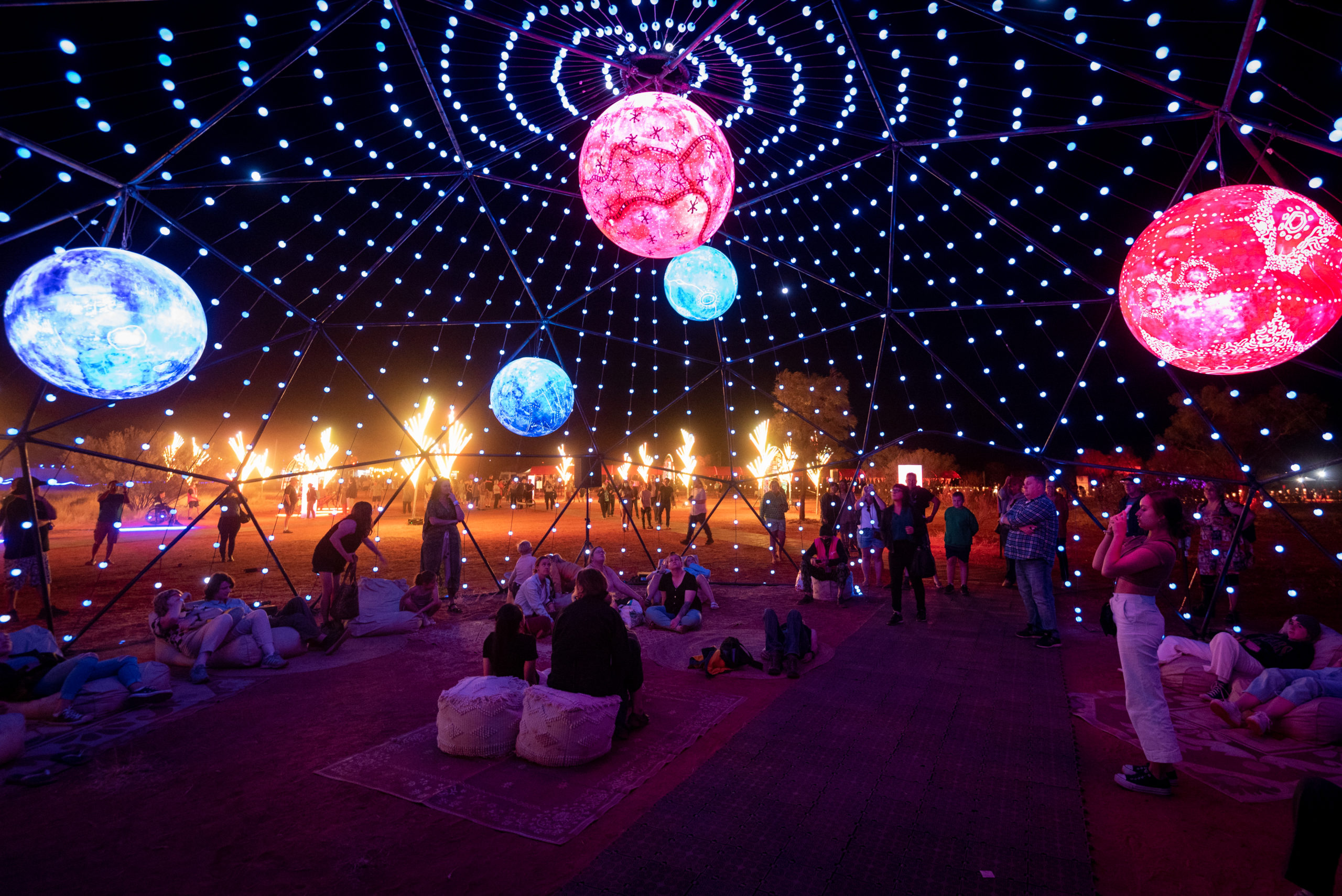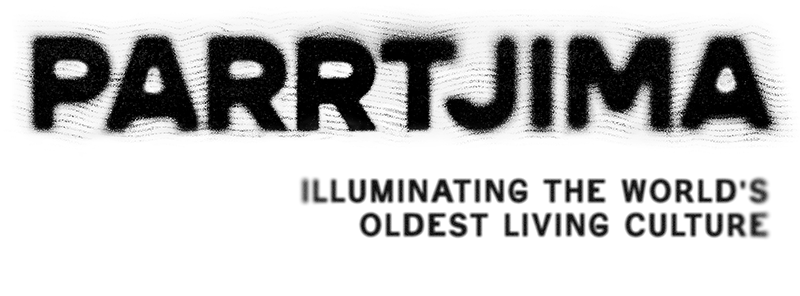We’ve been searching through our archives to find our favourite Parrtjima installations.
It was a hard job as there’s so much visual and theatrical spectacle at Parrtjima – the only authentic Aboriginal light festival of its kind.
Set against the 300 million-year-old natural canvas of the MacDonnell Ranges in Central Australia, the free 10-night festival first came to Alice Springs (Mparntwe) in 2016, and reinvents itself each year with an array of live music, talks, performances and workshops.
It also brightens up the already striking Red Centre with illuminated installations designed to dazzle and delight, and offer new insights and ways of engagement.
Below are seven of our most favourite installations from Parrtjima over the years.
Grounded (Parrtjima 2018)
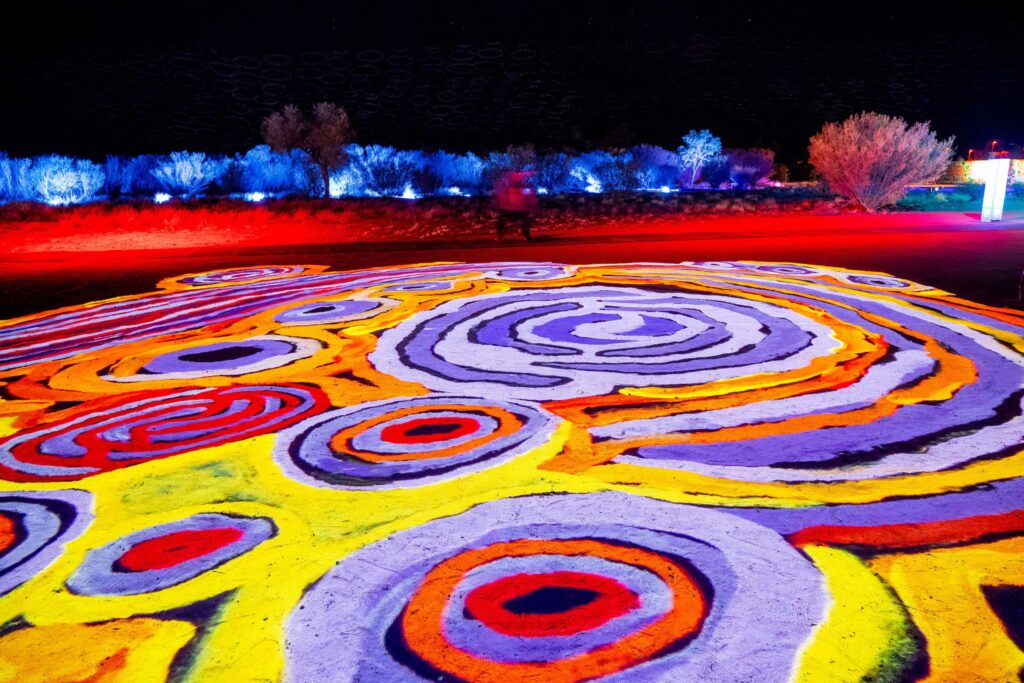
How awesome is Grounded?
A giant, seamless canvas on country, children and adults alike love to dance and stroll through swirls of colour in this popular Parrtjima installation.
We haven’t been able to resist sitting on the changing art carpet ourselves, letting the sand trickle through our fingers as animated Aboriginal artworks gently wash over us.
Grounded is an echo of the sand ceremonies which were enacted seasonally in Aboriginal culture. It internalises the pride and hope of ancient stories, highlighted by a diversity of Aboriginal artworks projected on to the red sand of Desert Park.
When you stand on country in the Red Centre, Grounded seeps into your soul, just like the red sand when scrunched between your toes. It returns every year with new artworks.
The Language of the Stockmen (Parrtjima 2019)

Just check out the size of this extraordinary horse and stockman sculpture.
Tiny wire sculptures, by Tapatjatjaka Art artists Johnny Young and David Wallace, were turned into four-metre high installations by young local Central Australian artists for Parrtjima in 2019.
Australian lighting supremo Richard Neville, who works regularly with Vivid Sydney, did the amazing job of illuminating the sculptures from within.
The Language of the Stockmen was part of a group of six installations which explored how Aboriginal vernaculars have changed to accommodate new ways of working and living since colonisation.
We loved this installation so much we plastered the pic on one of our office walls.
MacDonnell Ranges Show (Parrtjima 2020)
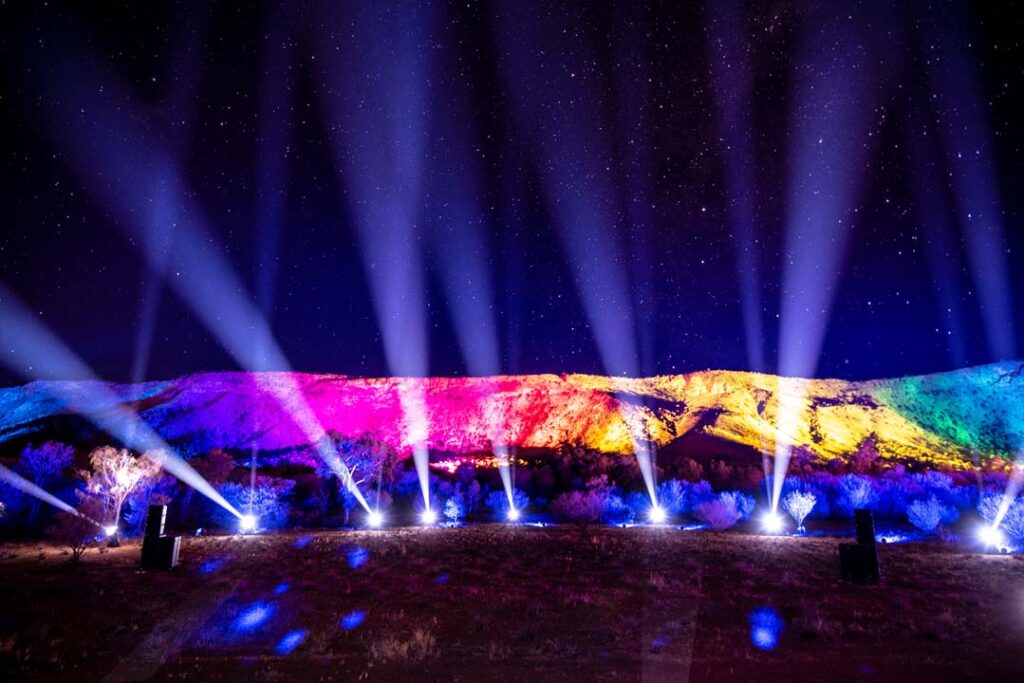
Parrtjima is a once in a lifetime travel experience which each year offers up many stunning and thought-provoking installations and performances.
We’ve seen this ancient Red Centre country transformed over the years, and no installation is more dazzling than when the majestic MacDonnell Ranges are brought to life with spectacular lighting effects.
We couldn’t agree on which Ranges Show shot was the best but we thought this one was pretty special. We all reckon that it’s an emotional experience and a spiritual journey that showcases and lights up the world’s oldest living culture in new and extraordinary ways.
Merging Kultcha (Parrtjima 2021)
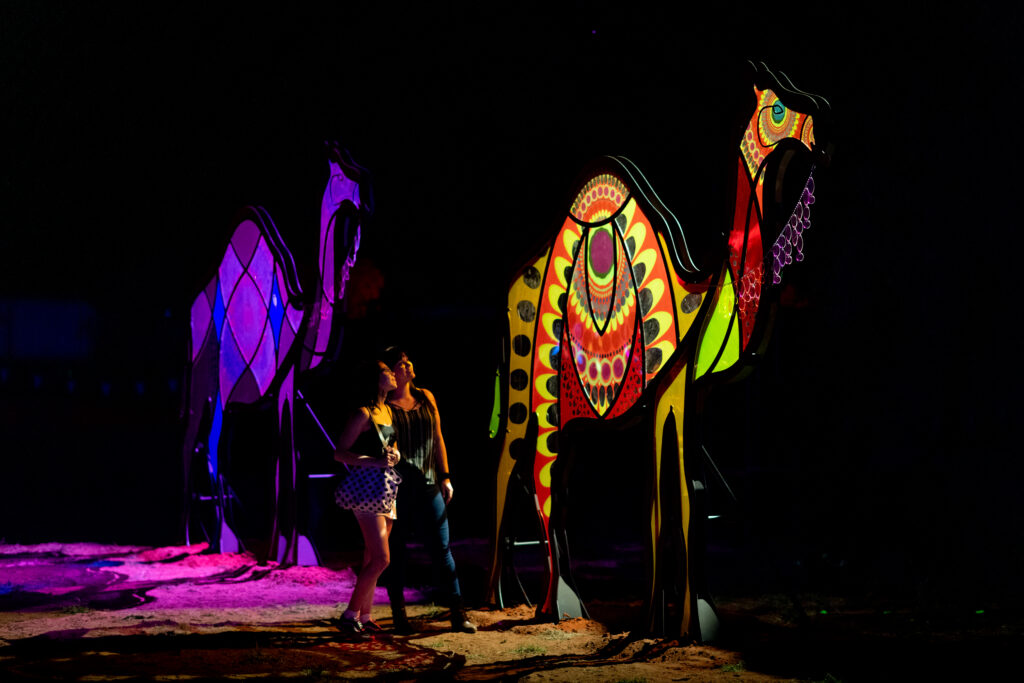
We simply adored the train of five larger-than-life illuminated camels.
Each camel, up to three metres high, featured a mosaic of coloured glass for a stained-glass window effect that cast beautiful shadows with shimmering light onto the red sand of Desert Park.
Called Merging Kultcha, this extraordinary installation brought Central Australian artist Chantelle Mulladad’s artwork, Crossroads, to life. Her artwork was also wrapped across three carriages of the iconic Ghan train which travelled from Darwin to Alice Springs to light up for Parrtjima 2021.
Merging Kultcha celebrated the rich and joint history of the Afghan cameleers and Arrernte people in the Red Centre. Chantelle, who has Indigenous and Afghan heritage, embodies these two important histories of the desert and was blown away by how Parrtjima illuminated her heritage.
In fact, we loved the glowing camels so much we brought them back to Parrtjima the following year as part of a discovery path leading towards the festival site.
Tailoring Kultcha (Parrtjima 2021)

Parrtjima transformed Todd Mall in Alice Springs CBD into an exhibition of light and textiles in 2021.
Curated by National Indigenous Fashion Awards (2020) Creative Director, Nina Fitzgerald, this beautiful installation showcased the innovation and diversity of Aboriginal and Torres Strait Islander artists and designers.
It also captured how textiles are changing the way our First Nations artists transmit their age-old cultural stories.
Captivating us with one beautifully ornate print at a time, Tailoring Kultcha highlighted the varied and unique designs that are emerging from all corners of the nation.
Night Sky (Parrtjima 2022)
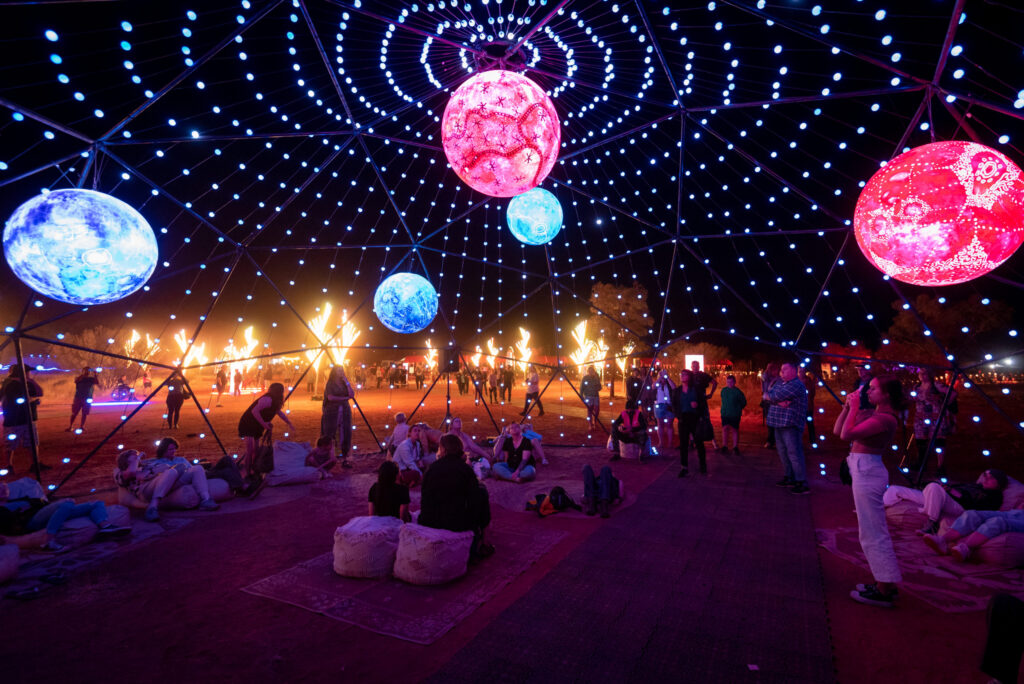
Lying on bean bags under 1,200 beautifully illuminated orbs suspended like a blanket of stars from a 15 metre diameter dome was an unforgettable experience for us at Parrtjima in 2022.
Created in collaboration with artist Carmen Glynn-Braun and Common Ground, the Night Sky installation encouraged everyone to raise their gaze to the starry skies above while transporting us all to dreamtime stories through an audio landscape.
Night Sky was one of nine installations as part of the 2022 theme Sky Country, with its focus on our place in the universe and the relationship Aboriginal people have with the environment.
Reading the sky helps Aboriginal people understand their place on Country and in 2022 we thought it would be a really nice introduction to Central Australia and Parrtjima to shift our focus skywards.
Listening with Heart (Parrtjima 2023)
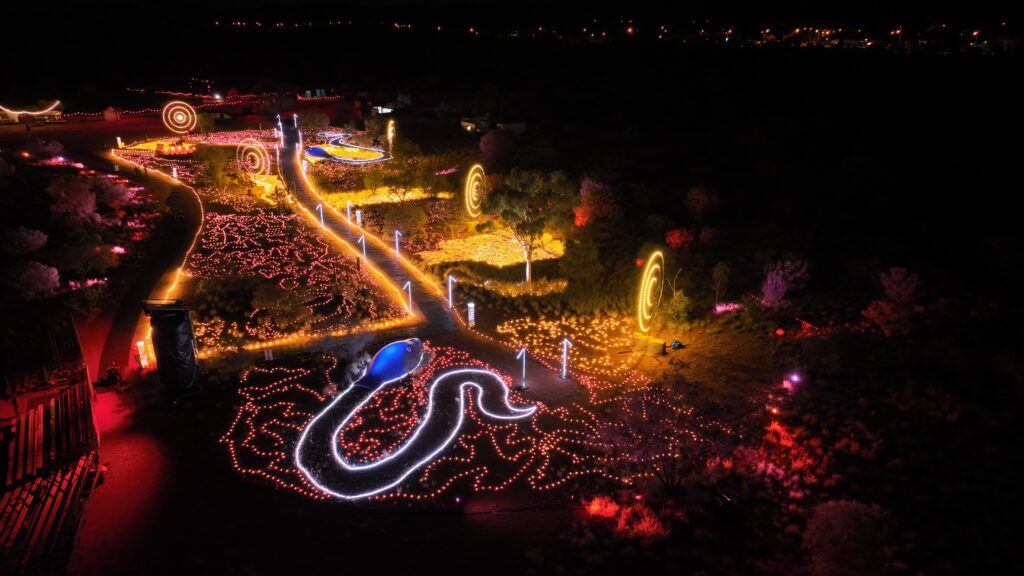
Part of an immersive experience never before presented, Parrtjima featured one, large-scale light and sound installation at Desert Park in 2023.
And it was sensational.
Listening with Heart showcased the talent of Maruku artist Rene Kulitja, who along with a group of artists from Mutitjulu (near Uluru) created the original artwork that frames the powerful Statement from the Heart.
Gently guided by the soundscapes of the Kuniya (python woman) story, visitors walked in the footprints of the artwork, and experienced a light-scape installation based on the story of the Mala (rufous hare-wallaby) people.
The Mala story was symbolised by wallaby footprints, which formed a pathway stretching from one end of the installation to the other.
With three-metre high structures lining the main path, there were also large glowing eggs at either end which represented the heads of the Kuniya breaking the ground’s surface.
As we said – sensational!
